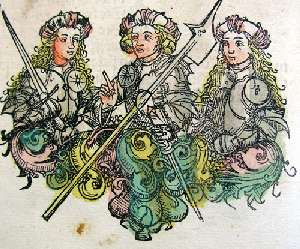|

The
Amazons of Lemnos
In ancient tradition the
island Lemnos (also Limnos)
was much connected with the
Amazons. The ancients called
this island «predominated by
women».
Aim of the exploring
expedition was to find
prehistoric traces which may
be connected with the
Amazons. Many relics have
been discovered and
investigated in
consideration of the current
research results on the
Thermodon Amazons in
northern Turkey - the
classical homeland of the
Amazons.
The investigations on Lemnos
have increased the knowledge
of the Amazons in many
respects. They have detected
a lot of conformity and
concurrence between the
Thermodon region - the
classical homeland of the
Amazons - and Lemnos. Those
parallels are so striking
that a connection between
the Thermodon Amazons and
the Lemnian Amazons seems to
be indisputable.
Furthermore, it is possible
that they have discovered
the first contemporary
representation of an Amazon
in a prehistoric rock
engraving.
In the ancient realm of myth
there is the account that in
prehistoric times the island
Lemnos was only inhabited by
women. This island was
called gynaikokratumene,
which means reigned by
women. In the Greek myth
about the Argonauts a group
of men comes to this island
on their way to the land of
Colchis (in the East of the
Black Sea). According to
this account this island was
only inhabited by women, a
queen named Hypsipyle ruled
over this women's state. It
is interesting that the
women of Lemnos received the
Greeks kindly. These women
of Lemnos lived as
self-confident Amazons on
this island, their aim of
life was not focused on
fighting against men.
Quite obviously, this myth
reflects former matriarchal
life on this island.
Poliochni
Excavations there resulted
in many amazing finds. In
Poliochni there has been
excavated a town, which
exceeded all contemporary
settlements.
There has been discovered a
town which was nearly twice
as large as contemporary
Troy. The Early Bronze Age
town of Poliochni had large
roomy houses which were
arranged in blocks along a
North-South main road.
By-roads crossed this main
road at right angles, and at
the crossings there were
little places with wells and
drainages.
The town was surrounded by a
stone wall which was 5
meters high, and there were
slots for archers. This is
rather surprising because at
this period only at
Poliochni there have been
found arrow-heads! It is an
amazing parallel to the
Amazons because the Amazons
were considered as
outstanding archers. The
inhabitants of Poliochni
seem to have been rather
wealthy, so there has been
discovered a valuable
treasure in the ruins.
A special feature of
Poliochni must be pointed
out: The town consisted of
uniform large dwelling
houses which demonstrate
that there existed a society
with very little social
differences. This kind of
social order is a typical
sign of matriarchy (female
rule).
At last, there is a further
striking coincidence: The
name of the capital of
Lemnos is Mirina. According
to the ancient mythical
tradition the first
outstanding Amazon queen was
named Myrina!

Click thumbnails to see it
larger
The Classical Legend
A member of a nation of
women warriors reputed to
have lived in Scythia. Often
amazon,
A tall, aggressive,
strong-willed woman.
I
In classical legend the
Amazons were a tribe of
warrior women. Their name is
supposedly derived from
Greek a-mazos,
“without a breast,” because
according to the legend they
cut off their right breasts
so as to be better able to
shoot with a bow and arrow.
This folk etymology, like
most folk etymologies, is
incorrect, but the Amazons
of legend are not so
completely different from
the historical Amazons, who
were also warriors. The
historical Amazons were
Scythians, an Iranian people
renowned for their cavalry.
The first Greeks to come
into contact with the
Iranians were the Ionians,
who lived on the coast of
Asia Minor and were
constantly threatened by the
Persians, the most important
of the Iranian peoples.
Amazōn is the Ionian
Greek form of the Iranian
word ha-mazan,
“fighting together.” The
regular Greek form would be
hamazōn, but because
the Ionians dropped their
aitches like Cockneys,
hamazōn became
amazōn, the form taken
into the other Greek
dialects.

Battle Of Amazons-Rubens
II
Amazon (ăm'əzŏn)
, in Greek
mythology, one
of a tribe of
warlike women
who lived in
Asia Minor. The
Amazons had a
matriarchal
society, in
which women
fought and
governed while
men performed
the household
tasks. Each
Amazon had to
kill a man
before she could
marry, and all
male children
were either
killed or maimed
at birth. It was
believed that
the Amazons cut
off one breast
in order to
shoot and throw
spears more
effectively.
They were
celebrated
warriors,
believed to have
been the first
to use cavalry,
and their
conquests were
said to have
included many
parts of Asia
Minor, Phrygia,
Thrace, and
Syria. Several
of the finest
Greek heroes
proved their
mettle against
the Amazons:
Hercules took
the golden
girdle of Ares
from their queen
Hippolyte;
Theseus abducted
Hippolyte's
sister Antiope
and then
defeated a
vengeful army of
Amazons at
Athens. A
contingent of
Amazons fought
with the Trojans
under
Penthesilea.

III
The Amazons
Amazons, the women warriors
of Greek Mythology. The name
Amazon in Greek mean "those
who have no breasts",
refering to the fact that
the Amazons cut off one of
their breasts in order to
better
draw a bow and hurl a spear.
They were said to have
originally been the
daughters of Ares and the
nymph Harmonia, whose girdle
was worn by the Amazon
queen. Mythically the
Kingdom of the Amazons lie
to the North of Greece,
perhaps in Thrace, or even
as far as the Danube river.
The Amazons were very
non-conforming to the
standard of the day: they
despised men, and killed all
male babies. The males that
did survive were treated as
servants and slaves, and had
no rights in the matriarchal
society. They worshiped
Artemis, goddess of the
hunt, and rejected most of
the male gods.
In myths they often served
as a direct opposite to the
hero of the myth. Herakles
met up with Amazon Queen
Hippolyta when he attempted
to take her girdle to
fulfill his ninth labour.
Hippolyta was willing to
give the hero her girdle,
but the goddess Hera sent
the other Amazons into a
frenzy, during which
Herakles accidentally killed
Hippolyta. Theseus too had
hard times with the warrior
women of Greek Mythology. He
abducted Antiope and raped
her. He took her back to
Athens with him so she could
give birth to their child,
who was later named
Hippolytus. The other
Amazons followed and lay
siege to Athens, but the
Athenians were able to
defeat them. The Amazons
also sent an army to assist
Troy during the Trojan war,
but the army was soon
recalled after Achilles
killed their queen,
Penthesilea.
What happened to these
warrior women? No one really
knows. They were thought to
have built the original
Temple to Artemis at
Ephesus, but that seems to
be the only evidence of
their existance outside of
Greek Mythology.
Back|Home|Next
Font used is
BD
Quattra
All
material, webset, graphics & creations were
made by © Sirpa Bister 2005 aka Dreamer at
DDezign's.
The research for material on this page; by
Sirpa Bister aka Dreamer, Assistante Head
Translator of WOSIB. All is made at the
behalf of WOSIB Translators Garden for to
celebrate the 5th year of WOSIB, and may not
be copied, duplicated or used without
restrict permission of the respective owner. |




